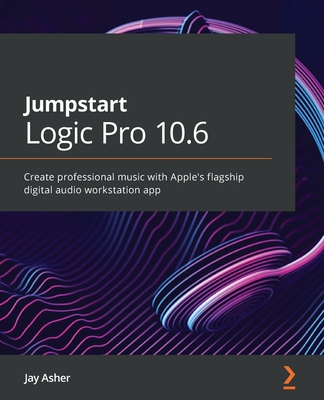Audio Sampling: A Practical Guide
暫譯: 音頻取樣:實用指南
Sam McGuire, Roy Pritts
- 出版商: Focal Press
- 出版日期: 2007-10-01
- 定價: $1,750
- 售價: 5.0 折 $875
- 語言: 英文
- 頁數: 232
- 裝訂: Paperback
- ISBN: 0240520734
- ISBN-13: 9780240520735
-
相關分類:
軟體工程
立即出貨 (庫存 < 3)
買這商品的人也買了...
-
 $970Introduction to Algorithms, 2/e
$970Introduction to Algorithms, 2/e -
 Visual Basic.Net 程式設計經典
Visual Basic.Net 程式設計經典$690$545 -
 建構嵌入式 Linux 系統
建構嵌入式 Linux 系統$780$616 -
 $1,274Wireless Communications: Principles and Practice, 2/e (Paperback)
$1,274Wireless Communications: Principles and Practice, 2/e (Paperback) -
 $836PSP: A Self-Improvement Process for Software Engineers (Hardcover)
$836PSP: A Self-Improvement Process for Software Engineers (Hardcover) -
 Windows Server 2003 Active Directory 建置指南, 2/e
Windows Server 2003 Active Directory 建置指南, 2/e$600$474 -
 SQL 語法範例辭典
SQL 語法範例辭典$550$435 -
 多媒體概論 (Fundamentals of Multimedia)
多媒體概論 (Fundamentals of Multimedia)$690$676 -
 聖殿祭司的 ASP.NET 2.0 專家技術手冊─使用 C#, 2/e
聖殿祭司的 ASP.NET 2.0 專家技術手冊─使用 C#, 2/e$720$569 -
 新一代 ASP.NET 2.0 網站開發實戰-使用 C# 以及 VB2005
新一代 ASP.NET 2.0 網站開發實戰-使用 C# 以及 VB2005$580$493 -
 新一代購物網站 TWE-Commerce 架設與管理, 2/e
新一代購物網站 TWE-Commerce 架設與管理, 2/e$580$493 -
 MIS 網管聖經
MIS 網管聖經$620$527 -
 寫給 SA 的 UML/MDA 實務手冊
寫給 SA 的 UML/MDA 實務手冊$350$298 -
 ASP.NET 2.0 介面設計與資料存取 (Professional ASP.NET 2.0)
ASP.NET 2.0 介面設計與資料存取 (Professional ASP.NET 2.0)$650$514 -
 Visual C# 2005 初學指引
Visual C# 2005 初學指引$580$493 -
 C++ Primer, 4/e (中文版)
C++ Primer, 4/e (中文版)$990$891 -
 PCI Express 系統架構 (PCI Express System Architecture)
PCI Express 系統架構 (PCI Express System Architecture)$880$695 -
 最新 Java 2 程式語言, 2/e
最新 Java 2 程式語言, 2/e$650$429 -
 現代嵌入式系統開發專案實務-菜鳥成長日誌與專案經理的私房菜
現代嵌入式系統開發專案實務-菜鳥成長日誌與專案經理的私房菜$600$480 -
 Web Data Mining: Exploring Hyperlinks, Contents, and Usage Data 2/e(Hardcover)
Web Data Mining: Exploring Hyperlinks, Contents, and Usage Data 2/e(Hardcover)$2,450$2,328 -
 Photoshop CS3 實力養成暨評量
Photoshop CS3 實力養成暨評量$450$356 -
 做簡報前要學會的 36 套設計技巧
做簡報前要學會的 36 套設計技巧$450$351 -
 WiMAX 技術原理與應用 (Fundamentals of WiMAX)
WiMAX 技術原理與應用 (Fundamentals of WiMAX)$580$458 -
 Photoshop CS3 實力養成暨評量解題秘笈
Photoshop CS3 實力養成暨評量解題秘笈$200$158 -
 VBScript 500 個活用範例 Windows 自動化技術大全 for Vista/XP/2000
VBScript 500 個活用範例 Windows 自動化技術大全 for Vista/XP/2000$590$460
商品描述
Description
Bringing sampling to a new generation of audio engineers and composers Audio Sampling explains how to record and create sampled instruments in a software setting. There are many things that go into creating a sampled instrument and many things that can go wrong, this book is a step by step guide through the process, from introducing sampling, where it begins to recording editing and using samples, providing much sought after detailed information on the actual process of sampling, creating sampled instruments as well as the different ways they can be used.
The software used is the NN-XT a sampler that is a part of the Reason studio software and ProTools LE, however the material discussed is applicable and can be used with any sampler.
The companion website has exclusive material including a comprehensive comparison of the different hardware software available, as well as audio examples and video clips from each stage of the process
Table of Contents
1 Introduction to Sampling
What is sampling?
A sampler survey
Basic Sampler Expectations
Other expectations
Additional software sampler features
Benefits to using samplers without creating your own instruments
Benefits to creating your own sampled instruments
Summary
2 Making connections
Required equipment
Capturing the sound source
Using microphones
Using a line input / instrument input
Using microphone preamplifiers
Using analog to digital converters
Using audio interfaces
Using an alternative audio interface
Hooking it all together
Cable types
Balanced vs. unbalanced
Grounding
MIDI connections
General equipment tips and tricks
3 Source preparation
Choosing your source
Preparing your source
Understanding your source
Putting it all together
4 Recording the First Sample
Ear training
Goals
Transparent listening
Focused listening
Listening memory
Projected listening
Summary
Basic Acoustic Issues
Microphone Choice and Placement
The recording session
Tidying up
5 Sample Editing
Editing styles
Basic editing
Advanced editing in the digital audio workstation
Adding additional effects/processors
6 Creating the Instrument
Importing files into zones
Advanced mapping
Fine tuning
An example of mapping
Additional sampler features
7 Using Samples
MIDI
Musical terms and definitions
Sampling, composition and orchestration: a maximum of ingenuity with a minimum of resources
Musical terms
Compositional Techniques
Performance characteristics
MIDI Performance control
Observations
8 Examining the roots of sampling
Timetable of processes
Timetable of historically innovative systems
Bibliography
9 Thoughts on the future of sampling
Modeling
Future uses of sampling
Summary
商品描述(中文翻譯)
**描述**
音頻取樣為新一代音頻工程師和作曲家帶來了新的機會。《音頻取樣》解釋了如何在軟體環境中錄製和創建取樣樂器。創建取樣樂器涉及許多步驟,並且可能出現許多問題,本書提供了一個逐步的指南,從介紹取樣開始,到錄製、編輯和使用樣本,提供了有關取樣實際過程的詳細資訊,創建取樣樂器以及它們的不同使用方式。
所使用的軟體是NN-XT,這是一個屬於Reason工作室軟體和ProTools LE的取樣器,然而所討論的材料適用於任何取樣器。
伴隨的網站提供獨家材料,包括不同硬體和軟體的全面比較,以及每個過程階段的音頻範例和視頻片段。
**目錄**
1. 取樣介紹
取樣是什麼?
取樣器調查
基本取樣器期望
其他期望
附加軟體取樣器功能
使用取樣器而不創建自己的樂器的好處
創建自己的取樣樂器的好處
總結
2. 建立連接
所需設備
捕捉聲音來源
使用麥克風
使用線性輸入/樂器輸入
使用麥克風前置放大器
使用類比轉數位轉換器
使用音頻介面
使用替代音頻介面
將所有設備連接起來
電纜類型
平衡與不平衡
接地
MIDI 連接
一般設備提示和技巧
3. 源準備
選擇您的來源
準備您的來源
理解您的來源
將所有內容整合在一起
4. 錄製第一個樣本
耳訓練
目標
透明聆聽
專注聆聽
聆聽記憶
預測聆聽
總結
基本聲學問題
麥克風選擇和放置
錄音會議
整理
5. 樣本編輯
編輯風格
基本編輯
數位音頻工作站中的進階編輯
添加額外效果/處理器
6. 創建樂器
將檔案導入區域
進階映射
微調
映射示例
附加取樣器功能
7. 使用樣本
MIDI
音樂術語和定義
取樣、作曲和編曲:以最少的資源發揮最大的創意
音樂術語
作曲技術
表演特徵
MIDI 表演控制
觀察
8. 檢視取樣的根源
過程時間表
歷史創新系統時間表
參考書目
9. 對取樣未來的思考
建模
取樣的未來用途
總結













